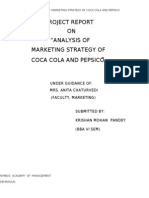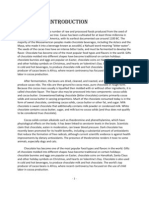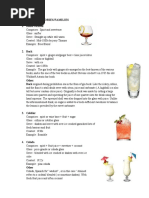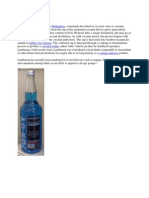Nata de Coco
Nata de Coco
Uploaded by
happy meCopyright:
Available Formats
Nata de Coco
Nata de Coco
Uploaded by
happy meOriginal Description:
Copyright
Available Formats
Share this document
Did you find this document useful?
Is this content inappropriate?
Copyright:
Available Formats
Nata de Coco
Nata de Coco
Uploaded by
happy meCopyright:
Available Formats
Nata de coco
Nata de coco, also marketed as coconut gel, is a chewy, translucent, jelly-like food
produced by the fermentation of coconut water, which gels through the production
of microbial cellulose by Komagataeibacter xylinus. Originating in the Philippines,
nata de coco was originally invented in 1949 by Teodula K. Kalaw as an alternative
to the traditional Filipino nata de piña which is made from pineapples. It is most
commonly sweetened as a candy or dessert, and can accompany a variety of foods,
including pickles, drinks, ice cream, puddings, and fruit cocktails.
Nata de coco comes from the Spanish meaning "cream of coconut" or "coconut milk-
skin"
Nata de coco was invented in 1949 by Teodula Kalaw Africa, a Filipina chemist
working for the National Coconut Corporation (now the Philippine Coconut
Authority). It was originally conceived as an alternative to nata de piña, another gel-
like Filipino dessert produced since the 18th century. This was because though the
demand was high, nata de piña was seasonal, as it relied on pineapple harvests from
the declining Philippine piña fiber industry.
Commercial production of nata de coco began in 1954, when the Philippine
Coconut Authority opened a branch in Alaminos, Laguna and introduced the
technology to local farmers. Nata de coco production was later optimized in the mid-
1970s through the efforts of a team of microbiologists led by Priscilla C. Sanchez. In
the 20th century, the demand for coconuts increased. Products from coconuts
became a major export product of the Philippines, including nata de coco.
You might also like
- Milktea Vs Iced CoffeeDocument3 pagesMilktea Vs Iced CoffeeIvon Shane Tatad Tejero0% (1)
- Consumer Behaviour Towards ChocolateDocument54 pagesConsumer Behaviour Towards ChocolateSeema Rani100% (2)
- Project of Marketing Management On NescafeDocument15 pagesProject of Marketing Management On NescafePallavi Vats72% (18)
- Cacao: Submitted By: Madelyn O. Arimado Section: BSA 2A Skills and Development Summer Class 2021Document1 pageCacao: Submitted By: Madelyn O. Arimado Section: BSA 2A Skills and Development Summer Class 2021Madelyn Arimado100% (1)
- Analysis of Marketing Strategy of Coca Cola and PepsiDocument88 pagesAnalysis of Marketing Strategy of Coca Cola and PepsiYogendra PoswalNo ratings yet
- Home Economics BeveragesDocument17 pagesHome Economics BeveragesAshmita Mahadeosingh100% (1)
- Davao CacaoDocument12 pagesDavao CacaoEli Leopoldo GenestonNo ratings yet
- Chocolate History in EnglishDocument104 pagesChocolate History in Englishmmano27No ratings yet
- Chocolate History and Top Chocolate Brands in The PhilippinesDocument2 pagesChocolate History and Top Chocolate Brands in The PhilippinesMari NamocoNo ratings yet
- Bottled Water in EgyptDocument25 pagesBottled Water in EgyptAbdelrahman ElkadyNo ratings yet
- Nata de Coco 1Document16 pagesNata de Coco 1ieshamaridumolNo ratings yet
- History of Chocolate PDFDocument6 pagesHistory of Chocolate PDFIbrahim KhleifatNo ratings yet
- Chicha Morada - WikipediaDocument13 pagesChicha Morada - WikipediaClaudia TuanamaNo ratings yet
- MezcalDocument4 pagesMezcalandrija rokiNo ratings yet
- Comida Puerto RicoDocument2 pagesComida Puerto RicoElisaena PestanaNo ratings yet
- Coco Quench Integrated Marketing PlanDocument80 pagesCoco Quench Integrated Marketing PlanCeline Duran100% (1)
- MiloDocument5 pagesMiloGayani Dulmala ImbulanaNo ratings yet
- ChocolateDocument13 pagesChocolatekks sdmNo ratings yet
- The Coffee HistoryDocument29 pagesThe Coffee HistoryEugenio MichelleNo ratings yet
- Print Now Coca ColaDocument44 pagesPrint Now Coca Colacarlotavictoria0% (1)
- PGTO FINALSDocument13 pagesPGTO FINALSTrizha MatillanoNo ratings yet
- ChoclateDocument13 pagesChoclateAbdelghani MakkaouiNo ratings yet
- Final Paper IIIDocument13 pagesFinal Paper IIIMary PaladanNo ratings yet
- SnickersDocument45 pagesSnickersKhadar KhanNo ratings yet
- Chocolate: Theobroma CacaoDocument8 pagesChocolate: Theobroma CacaoManan JainNo ratings yet
- Introduction To Chocolate IndustryDocument9 pagesIntroduction To Chocolate IndustrySachin Nagpal100% (1)
- IntroductionDocument29 pagesIntroductionLarisa CosteaNo ratings yet
- What Are The Benefits For Regular Consumption of Nata de CocoDocument9 pagesWhat Are The Benefits For Regular Consumption of Nata de CocoHalimah100% (2)
- C1 1Document3 pagesC1 1Jem TalaveraNo ratings yet
- Lyza Sts SUPER FINALDocument17 pagesLyza Sts SUPER FINALconan juarbalNo ratings yet
- ChocolateDocument28 pagesChocolateLarisa CosteaNo ratings yet
- Training & DevelopmentDocument59 pagesTraining & DevelopmentYugendra Babu KNo ratings yet
- Coco CafeDocument3 pagesCoco Cafewirp27No ratings yet
- Origins:: Lambanog (Philippine Coconut Wine)Document4 pagesOrigins:: Lambanog (Philippine Coconut Wine)Justine MembridoNo ratings yet
- Cocktail CategoriesDocument3 pagesCocktail CategoriesBayu AdithiaNo ratings yet
- Process of Making ChocolateDocument11 pagesProcess of Making ChocolatenooneyouknowrnNo ratings yet
- Technical ReportDocument24 pagesTechnical ReportAngeline Joyce RamirezNo ratings yet
- Background and History of NestleDocument3 pagesBackground and History of NestleJairah AtentarNo ratings yet
- Chocolate Info.Document6 pagesChocolate Info.POPO213No ratings yet
- History of CoffeeDocument6 pagesHistory of Coffeetolentino liezlNo ratings yet
- ChocolateDocument20 pagesChocolatesagar pajankarNo ratings yet
- Nera Justine Claire Bsab 3 1 Marketing PlanDocument35 pagesNera Justine Claire Bsab 3 1 Marketing PlanCj M SapadNo ratings yet
- Marketing CommunicationDocument29 pagesMarketing CommunicationTahir Meo100% (1)
- Tle 8 Lesson 3.1Document32 pagesTle 8 Lesson 3.1celinejoi pajarillagaNo ratings yet
- Philippines LambanogDocument22 pagesPhilippines LambanogNoelp Ferreras100% (2)
- ChocolateDocument20 pagesChocolateotakmesumNo ratings yet
- Coca Cola SuperbrandsDocument1 pageCoca Cola Superbrandsmaur08No ratings yet
- Native Delicacies: By: Jhim BernardoDocument32 pagesNative Delicacies: By: Jhim Bernardomar cris velasco100% (1)
- Philippine Tropical Wines and Craft Beer, Liquor and SpiritsDocument7 pagesPhilippine Tropical Wines and Craft Beer, Liquor and SpiritsHaha HahaNo ratings yet
- Study-Of-Consumer-Behaviour-Towards-Nestle-And-Cadbury-Choclates FINAL EDITDocument69 pagesStudy-Of-Consumer-Behaviour-Towards-Nestle-And-Cadbury-Choclates FINAL EDIThuneet SinghNo ratings yet
- History Terminology Categories of Frozen ProductsDocument44 pagesHistory Terminology Categories of Frozen ProductsRai Ali HamzaNo ratings yet
- Case Studies 2Document12 pagesCase Studies 2patricia.aniyaNo ratings yet
- Chocolate is aDocument2 pagesChocolate is atoobanaeem111No ratings yet
- Hot Chocolate (Also Known As Hot Cocoa or Just Cocoa) Is A Heated Beverage Typically Consisting ofDocument9 pagesHot Chocolate (Also Known As Hot Cocoa or Just Cocoa) Is A Heated Beverage Typically Consisting ofxarx_xarxNo ratings yet
- ChocolateDocument33 pagesChocolateZila KhuzaimahNo ratings yet
- SalesmanshipDocument9 pagesSalesmanshipEjay RegilmeNo ratings yet
- Chocolate Creations: More than 160 Decadent and Delicious Chocolate DessertsFrom EverandChocolate Creations: More than 160 Decadent and Delicious Chocolate DessertsNo ratings yet
- Spirits Distilled: With cocktails mixed by Michael ButtFrom EverandSpirits Distilled: With cocktails mixed by Michael ButtRating: 3 out of 5 stars3/5 (2)
- MadonaDocument4 pagesMadonahappy meNo ratings yet
- Paper MakingDocument2 pagesPaper Makinghappy meNo ratings yet
- Mcu PhasesDocument1 pageMcu Phaseshappy meNo ratings yet
- Chemical Engineer Interview Questions and Answers 1. What Is Flow Control?Document4 pagesChemical Engineer Interview Questions and Answers 1. What Is Flow Control?happy meNo ratings yet
- 365 DaysDocument12 pages365 Dayshappy meNo ratings yet
- Think LifeDocument1 pageThink Lifehappy meNo ratings yet
- Think LifeDocument1 pageThink Lifehappy meNo ratings yet
- Think LifeDocument1 pageThink Lifehappy meNo ratings yet



































































